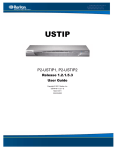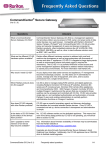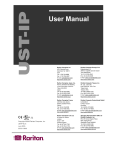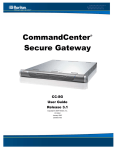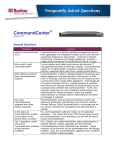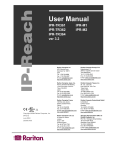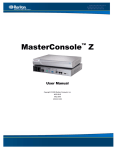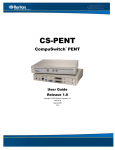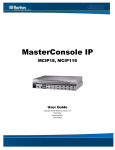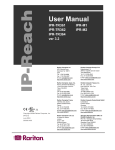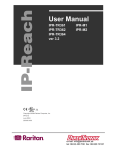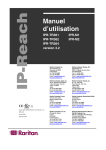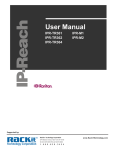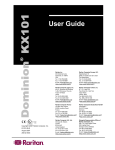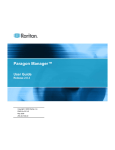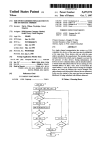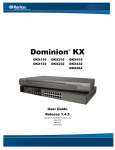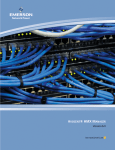Download Raritan P2-USTIP2 KVM switch
Transcript
USTIP P2-USTIP1, P2-USTIP2 Release 1.2 User Guide Copyright © 2006 Raritan Computer, Inc. PII-0J-E April 2006 255-30-6000 This page intentionally left blank. Copyright and Trademark Information This document contains proprietary information that is protected by copyright. All rights reserved. No part of this document may be photocopied, reproduced, or translated into another language without express prior written consent of Raritan Computer, Inc. ©Copyright 2006 Raritan, Paragon, IP-Reach, Dominion, CommandCenter, and the Raritan company logo are trademarks or registered trademarks of Raritan Computer, Inc. All rights reserved. Java is a registered trademark of Sun Microsystems, Inc. Internet Explorer is a registered trademark of Microsoft Corporation. Netscape and Netscape Navigator are registered trademarks of Netscape Communication Corporation. All other marks are the property of their respective owners. FCC Information This equipment has been tested and found to comply with the limits for a Class A digital device, pursuant to Part 15 of the FCC Rules. These limits are designed to provide reasonable protection against harmful interference in a commercial installation. This equipment generates, uses, and can radiate radio frequency energy and if not installed and used in accordance with the instructions, may cause harmful interference to radio communications. Operation of this equipment in a residential environment may cause harmful interference. Japanese Approvals Raritan is not responsible for damage to this product resulting from accident, disaster, misuse, abuse, non-Raritan modification of the product, or other events outside of Raritan’s reasonable control or not arising under normal operating conditions. C UL US LISTED 1F61 I.T.E. For assistance in the North or South America, please contact the Raritan Technical Support Team by telephone (732) 764-8886, by fax (732) 764-8887, or by e-mail [email protected] Ask for Technical Support – Monday through Friday, 8:00am to 8:00pm, Eastern. For assistance around the world, please see the last page of this guide for regional Raritan office contact information. Safety Guidelines To avoid potentially fatal shock hazard and possible damage to Raritan equipment: • Do not use a 2-wire power cord in any product configuration. • Test AC outlets at your computer and monitor for proper polarity and grounding. • Use only with grounded outlets at both the computer and monitor. When using a backup UPS, power the computer, monitor and appliance off the supply. Rack Mount Safety Guidelines In Raritan products which require Rack Mounting, please follow these precautions: • Operation temperature in a closed rack environment may be greater than room temperature. Do not exceed the rated maximum ambient temperature of the appliances (see Appendix A: Specifications). • Ensure sufficient airflow through the rack environment. • Mount equipment in the rack carefully to avoid uneven mechanical loading. • Connect equipment to the supply circuit carefully to avoid overloading circuits. • Ground all equipment properly, especially supply connections, such as power strips (other than direct connections), to the branch circuit. Login • • • • The default USTIP login user name is admin, and the default password is raritan. This user has administrative privileges. Passwords are case sensitive and must be entered in the exact case combination in which they were created. The default password raritan must be entered entirely in lowercase letters. To ensure security, change the default password as soon as possible. Default IP Address • USTIP ships with the default IP address of 192.168.0.192 Firmware • This manual applies to USTIP Firmware version 4.1 and above. CONTENTS i Contents Chapter 1: Introduction .................................................................. 1 USTIP Overview.........................................................................................................................1 Product Photos...........................................................................................................................2 Product Features........................................................................................................................3 Terminology ...............................................................................................................................4 Chapter 2: Installation.................................................................... 5 Configuring Target Servers ........................................................................................................5 Server Video Resolution......................................................................................................5 Windows XP Settings ..........................................................................................................5 Windows 2000 / ME Settings...............................................................................................6 Windows 95 / 98 / NT Settings ............................................................................................6 Linux Settings ......................................................................................................................6 Sun Solaris Settings ............................................................................................................6 Apple Macintosh Settings ....................................................................................................7 Configuring Network Firewall Settings .......................................................................................7 Physical Connections.................................................................................................................8 Initial Configuration ....................................................................................................................9 Remote Connection Using Raritan Multi-Platform Client and Raritan Remote Client .............12 MPC Requirements ...........................................................................................................12 Supported Browsers ..........................................................................................................12 Launch MPC ......................................................................................................................12 Launch RRC ......................................................................................................................13 Establish a Connection......................................................................................................14 Note to CommandCenter Users...............................................................................................15 Chapter 3: Operation – Administrative Functions........................ 17 Accessing the Administrative Functions ..................................................................................17 Local Admin Console.........................................................................................................17 Remote Admin Console.....................................................................................................18 Navigating the Administrative Menus.......................................................................................18 Network Configuration..............................................................................................................19 User Station Options ................................................................................................................20 Security Configuration..............................................................................................................21 Performance Settings...............................................................................................................23 Time and Date..........................................................................................................................24 Access Control List ..................................................................................................................25 Remote Syslog.........................................................................................................................26 View USTIP Status...................................................................................................................27 Restart or Shutdown the USTIP...............................................................................................28 Diagnostics...............................................................................................................................28 Appendix A: Specifications .......................................................... 29 Remote Connection .................................................................................................................29 Raritan Remote Client (RRC) Software ...................................................................................29 KVM Input ................................................................................................................................29 Cable Specifications.................................................................................................................30 KVM Switch Specifications ......................................................................................................30 Output Specifications ...............................................................................................................30 Appendix B: Frequently Asked Questions.................................... 31 Appendix C: Troubleshooting ....................................................... 35 Problems and Suggested Solutions.........................................................................................35 Event Log File and On-Screen Error Codes ............................................................................42 ii USTIP USER GUIDE Figures Figure 1 Front and Rear Views of the P2-USTIP ......................................................................................... 2 Figure 2 P2-USTIP1 Unit with Paragon UMTs ............................................................................................. 2 Figure 3 P2-EUST, P2-UST, and P2-USTIP1 Units..................................................................................... 2 Figure 4 Set Mouse Motion .......................................................................................................................... 7 Figure 5 P2-USTIP2 Rear Panel Connections ............................................................................................. 8 Figure 6 USTIP Wizard Screen.................................................................................................................... 9 Figure 7 USTIP Network Configuration Screen............................................................................................ 9 Figure 8 RRC Connection Window ............................................................................................................ 13 Figure 9 RRC Window ............................................................................................................................... 14 Figure 10 USTIP Admin Console ............................................................................................................... 17 Figure 11 Admin Icon in Navigator............................................................................................................. 18 Figure 12 USTIP Main Menu...................................................................................................................... 18 Figure 13 Configuration Menu.................................................................................................................... 19 Figure 14 Network Configuration Screen ................................................................................................... 19 Figure 15 USTIP UserStation Configuration Screen .................................................................................. 20 Figure 16 USTIP Security Configuration Screen........................................................................................ 21 Figure 17 USTIP Performance Settings Screen......................................................................................... 23 Figure 18 Time and Date Screen ............................................................................................................... 24 Figure 19 Access Control List Screen........................................................................................................ 25 Figure 20 Remote Syslog Configuration Screen ........................................................................................ 26 Figure 21 Remote Syslog Configuration Options ....................................................................................... 26 Figure 22 USTIP Main Menu...................................................................................................................... 27 Figure 23 Status Log Screen ..................................................................................................................... 27 Figure 24 USTIP Main Menu...................................................................................................................... 28 Figure 25 Diagnostic Console .................................................................................................................... 28 CHAPTER 1: INTRODUCTION 1 Chapter 1: Introduction USTIP Overview Thank you for purchasing Raritan’s USTIP, the industry-leading solution for multi-platform, high-performance, network-based, remote KVM console access, and a critical part of Raritan’s Paragon family of server management – one server, one dedicated monitor, one dedicated keyboard, and a single user station (monitor, keyboard, and mouse) for multiple servers – even servers of different platforms. USTIP enables highly-secure, multi-user, bandwidth-efficient, and software-independent access to your servers’ KVM consoles via a web browser for one or two users. It uses Raritan's powerful frame-grabber and Video Compression Algorithm to capture, digitize, and compress the video signal before transmitting to a remote PC. The remote user has direct access and total control of target servers for maintenance, administration, and trouble-shooting, from running GUI applications to BIOS-level troubleshooting, and even rebooting. A Paragon II system consists of several components: Main switching units (M Units), which serve as base units and matrix switches, securely connecting users to servers; Stacking units (S Units), which allow you to expand your system and connect to the M Units while conserving space; Computer-Interface Modules (CIMs) connected to each server; and either the User Station (P2-UST), which connects your keyboard, monitor, and mouse to the M unit and provides an intuitive On-Screen User Interface for accessing attached servers, or the Enhanced User Station (P2-EUST), providing all of the P2-UST features, plus superior video quality with manual skew compensation. In addition, the P2-USTIP1 and P2-USTIP2, one-and two-worker user stations, have integrated IP access and includes KVM over IP capability for anytime, anywhere access and control of servers along with a slim design and GUI for point-and-click remote access. The P2-USTIP supports IP access, enabling one or two remote users to access Paragon II-connected servers from anywhere via Web browser. The P2-USTIP2 also supports 128-bit SSL encryption and local authentication through Paragon II, or centralized authentication when used with Raritan’s CommandCenter Secure Gateway. Use USTIP for convenient access to servers anytime, from anywhere: • Control servers from within the building or across a campus • Manage servers at branch offices from a central site • Provide remote support for worldwide data centers • Troubleshoot, reconfigure, and reboot servers from home • Provide convenient and secure lights-out server management Access via Internet, LAN/WAN, or dial-up Modem USTIP provides a broad array of remote access methods to control any server connected to a Raritan KVM Switch. Since servers can also be accessed out-of-band with USTIP, remote access to mission-critical target servers is always available - even if the network is down. For reading ease, P2-USTIP1 and P2-USTIP2 units are called simply “USTIP.” 2 USTIP USER GUIDE Product Photos Figure 1 Front and Rear Views of the P2-USTIP Figure 2 P2-USTIP1 Unit with Paragon UMTs Figure 3 P2-EUST, P2-UST, and P2-USTIP1 Units CHAPTER 1: INTRODUCTION 3 Product Features Access • Remote KVM access via the Internet, LAN/WAN, or dial-up modem • Up to two simultaneous user throughput to switch(es) or server(s) • Web browser accessible • Remote access to serial devices (VT100) connected to USTIP serial port Performance • Superior compression algorithm for exceptional performance • No impact on target server performance • Automatic sensing of video resolution for optimum display • High-performance mouse tracking and synchronization Reliability • External modem using a dedicated modem port allows servers to be accessible even if network is unavailable Security • SSL 128-bit RSA public key, 128-bit RC4 private key encryption • Single, configurable TCP port for firewall protection Administration • Remote Administration via Web Browser interface • Simplified installation and user interface • User console for direct analog access to KVM switch • Extensive downloadable user event log • DHCP or fixed IP addressing • Supports Raritan’s CommandCenter-Secure Gateway and PCCI, Raritan’s Paragon– CommandCenter Integration 4 USTIP USER GUIDE Terminology This manual makes use of the following terms to indicate components of a typical USTIP configuration. While reading the manual, please refer to the diagram below for clarification when necessary. Target Server(s) Remote PC Local Access Console Local Admin Console Servers to be accessed remotely via USTIP and its connected KVM configuration. A Windows-based computer used to access and control target servers connected to USTIP. A user console consisting of a PS/2 keyboard, PS/2 mouse, and VGA monitor, directly attached to USTIP to control target servers locally (not through the network). Single-port USTIP models (USTIP1) allow connection of one local access console. A VT100 terminal directly attached to USTIP, used for administration and setup. From this console, you can access USTIP administration menus directly. You cannot view Target Servers of the connected KVM configuration using this screen. Although USTIP also allows remote administration via the network, the local admin console provides the most convenient means to perform initial setup. CHAPTER 2: INSTALLATION 5 Chapter 2: Installation Configuring Target Servers Before installing USTIP, first configure any target servers that you wish to access via USTIP, in order to ensure optimum performance, as outlined below. Note that the following configuration requirements apply only to target servers, not to the computers that you will be using to access USTIP remotely. Server Video Resolution For optimal bandwidth efficiency and video performance, target servers running graphical user interfaces such as Windows, X-Windows, Solaris, and KDE should be configured with desktop backgrounds set to a predominantly solid, light-colored graphic. Backgrounds featuring photos or complex gradients should be avoided. Ensure that the server’s video resolution and refresh rate are supported by USTIP, and that the signal is non-interlaced. USTIP supports the following video resolutions: Text Modes 640x480 @ 60Hz 640x480 @ 72Hz 640x480 @ 75Hz 640x480 @ 85Hz 720x400 @ 70Hz 720x400 @ 85Hz 800x600 @ 56Hz 800x600 @ 60Hz 800x600 @ 72Hz 800x600 @ 75Hz 800x600 @ 85Hz 1024x768 @ 60Hz 1024x768 @ 70Hz 1024x768 @ 75Hz 1024x768 @ 85Hz 1152x864 @ 60Hz 1152x864 @ 70Hz 1152x864 @ 75Hz 1280x960 @ 60Hz 1280x1024 @ 60Hz Windows XP Settings On target servers running Microsoft Windows XP, disable the “Enhanced Pointer Precision” option, and set the mouse motion speed exactly to the middle speed setting. These parameters are found in: Start → Settings → Control Panel → Printers and Other Hardware → Mouse → Pointer Options. Note: For Target Servers running Windows NT, 2000, or XP, you may wish to create a username to be used only for remote connections through USTIP. This allows you to keep the Target Server’s slow mouse pointer motion/acceleration settings exclusive to the USTIP connection only, as other users may desire faster mouse speeds. Windows XP and 2000 login screens revert to pre-set mouse parameters that differ from those suggested for optimal USTIP performance; therefore, mouse sync will not be optimal at these screens. If you are comfortable adjusting the registry on Windows target servers, you can obtain better USTIP mouse synchronization at login screens by using the Windows registry editor to change the following settings: Default user mouse motion speed = 0; mouse threshold 1= 0; mouse threshold 2 = 0. 6 USTIP USER GUIDE Windows 2000 / ME Settings On target servers running Microsoft Windows 2000 / ME, set the mouse pointer acceleration to “none” and the mouse motion speed exactly to the middle speed setting. These parameters are found in: Start → Settings → Control Panel → Mouse → Motion. Windows 95 / 98 / NT Settings On target servers running Microsoft Windows 95 / 98 / NT, set the mouse motion speed to the slowest setting in Start → Settings → Control Panel → Mouse → Motion. Linux Settings On target servers running Linux graphical interfaces, set the mouse acceleration to exactly 1 and set threshold to exactly 1. As mentioned above, please ensure that each target server running Linux is using a resolution supported by USTIP at a standard VESA resolution and refresh rate. Each Linux target server should also be set so the blanking times are within +/- 40% of VESA standard values. To check for these parameters: • Go to the Xfree86 Configuration file XF86Config • Using a text editor, disable all non-USTIP supported resolutions • Disable the virtual desktop feature, which is not supported by USTIP • Check blanking times (+/- 40% of VESA standard). • Restart computer Note: In many Linux graphical environments, the command CTRL+ALT+ + [plus sign key] will change the video resolution, scrolling through all available resolutions that remain enabled in the XF86Config file. Sun Solaris Settings All target servers must be configured to one of the display resolutions supported by USTIP. The most popular supported resolutions for Sun machines are: • • • • • • • 1024x768@60Hz 1024x768@70Hz 1024x768@75Hz 1024x768@85Hz 1152x900@66Hz 1152x900@76Hz 1280x1024@60Hz Target servers running the Solaris operating system must output VGA video (H-and-V sync, not composite sync). To change your Sun video card output from composite sync to the non-default VGA output, first issue the Stop+A command to drop to bootprom mode. Then, issue the command: setenv output-device screen:r1024x768x70 to change the output resolution. Issue the “boot” command to reboot the server. Alternatively, you may contact your Raritan representative to purchase a video output adapter. 13W3 Suns with composite sync output require APSSUN II Raritan guardian for use with USTIP. HD15 Suns with composite sync output require 1396C Raritan converter to convert from HD15 to 13W3 and an APSSUN II Raritan guardian converter to support composite sync. HD15 Suns with separate sync output require an APKMSUN Raritan guardian for use with USTIP. CHAPTER 2: INSTALLATION 7 Note that KVM switch brands other than Raritan’s may or may not properly handle PS/2-to-Sun signals. On target servers running the Solaris operating system, set the mouse acceleration value to exactly 1 and threshold to exactly 1. Set this at the graphical user interface (shown below), or with the command line “xset mouse a t” where “a” is the acceleration and “t” is the threshold. Figure 4 Set Mouse Motion Apple Macintosh Settings For target servers running an Apple Macintosh operating system, while using USTIP to access and control your target server, you must set the USTIP client (Raritan Remote Client) to “single cursor” mode. Dual cursor mode is not supported, and the two mouse pointers will not appear in sync if you attempt to control a Macintosh server via USTIP in dual cursor mode. Configuring Network Firewall Settings If you wish to access USTIP through a network firewall, your firewall must allow communication on TCP Port 5000. Alternatively, USTIP can be configured to use a different TCP port of your own designation (see Chapter 3: Administrative Functions, Network Configuration). In order to take advantage of USTIP's web-access capabilities, the firewall must allow inbound communication on TCP Port 443 – the standard TCP port for HTTPS communication. In order to take advantage of USTIP's redirection of HTTP requests to HTTPS (so that users may type the more common, "http://192.168.0.192", instead of "https://192.168.0.192"), then the firewall must allow inbound communication on TCP Port 80 – the standard TCP port for HTTP communication. 8 USTIP USER GUIDE Physical Connections Figure 5 P2-USTIP2 Rear Panel Connections Attaching a Local Console for Initial Configuration 1. Attach the included AC power cord to the USTIP unit and plug the other end into a nearby AC power outlet. 2. Connect the client PC to the USTIP ADMIN Port using a serial (DB9) cable. 3. Connect a standard Ethernet cable from the Network Port to an Ethernet switch, hub, or router. 4. On a USTIP1 unit, connect the single Paragon port to the User port on your UMT unit using a CAT5 cable. On a USTIP2 unit, connect both the upper and the lower Paragon ports to User ports on your UMT unit using CAT5 cables. The upper Paragon port allows you to download the Paragon database to the USTIP unit, and the lower Paragon port allows local access to the Paragon unit. 5. Launch a Hyperterminal session from the client PC. To access the Serial Admin Port, use HyperTerminal to configure specific settings with the following steps: A. In Windows, click on the Start menu in the lower left corner, then click Programs Æ Accessories Æ Communications Æ HyperTerminal to start a session. B. Name the HyperTerminal session, select a session icon - if required - and then click OK. C. In the Connect To window, click on the Connect Using drop-down arrow and select COM1 (or other option, depending on where your PC's serial cable is connected) and click OK. D. In the COM1 Properties window, click on the Port Settings tab. Make sure the Bits per second drop-down is 115200 and Flow control drop-down is set to NONE. Click OK. E. On the File menu, click Properties; click on the Settings tab, then click on the Emulation drop-down arrow and select VT100. i. Click ASCII Setup and ensure that the checkbox before Wrap lines that exceed terminal width is checked. ii. Click OK. iii. Click Terminal Setup and ensure that the checkbox before Keypad application mode is checked. iv. Click OK. 6. Power ON USTIP. CHAPTER 2: INSTALLATION 9 Initial Configuration During initial configuration, the USTIP Setup Wizard helps you quickly set up USTIP for the first time. The USTIP Setup Wizard appears only when accessing the Administrative Menus on a non-configured USTIP, and guides you through initial configuration parameters. The easiest way to perform this initial configuration is by using the Local Admin Console (see ‘Physical Connection’ instructions in the previous sections). 1. Power ON USTIP via the power switch on the back of the USTIP unit. 2. The Welcome to USTIP Setup Wizard Screen will appear on the Local Admin Console. Figure 6 USTIP Wizard Screen 3. Press the letter B on the Local Admin Console keyboard to begin the USTIP Setup Wizard. 4. The Network Configuration Screen appears. Figure 7 USTIP Network Configuration Screen 5. Use the Tab, Ç or È keys to select each line on the Network Configuration screen and the space bar, or the Å or Æ keys to toggle between available entries. Press the Enter, Tab or È keys when your entry on each line is complete. Below are descriptions of each field, and the appropriate values to assign. • Name: Designate a unique name for this USTIP unit, for example, “MiamiDataCenter.” Please note that this name should contain only alphanumeric characters, no spaces or symbols permitted. The default name is USTIP. • Enable Ethernet Interface: Designates whether USTIP should enable its Ethernet adapter as active (default: YES). 10 USTIP USER GUIDE Note: Network connections must be 10BASE-T or 100BASE-TX Ethernet − • • Line Speed & Duplex: Enter the visual efficiency for the monitor: Auto detect 10 Mbps/Full Duplex, 10 Mbps/Half Duplex, 100 Mbps/Full Duplex, or 100 Mbps/Half Duplex − Obtain IP address automatically (DHCP): ♦ YES: Enables dynamic IP addressing for USTIP. Each time USTIP boots, it requests an IP address from the local DHCP server. Note that this setting can make remote access to USTIP from outside the LAN difficult, since the dynamically assigned IP address must be known in order to initiate a connection. ♦ NO (default): Assigns a fixed IP address to the USTIP unit (recommended). IP Address: Type the IP address for USTIP given by your Network Administrator. Subnet Mask: Type a Subnet Mask provided by your Network Administrator. Default Gateway: Type the Default Gateway if your Network Administrator specifies one. − Enable Modem Interface: Enables Dial-up Modem access (default: YES). For USTIP, an external serial modem must be connected in order for this function to work properly. Enable Web Browser Interface: Enables Web browser access to USTIP (default: YES). Use Default TCP Port 5000: − YES (default): Utilizes the default port 5000. − NO: Enter an alternate port number. Note: In order to access USTIP from beyond a firewall, your firewall settings must enable twoway communication through the default port 5000 or the non-default port configured above. 6. 7. 8. 9. 10. Press CTRL+S to save entries. The Main Menu will appear. On the Main Menu, select [R] Restart or shutdown the USTIP, and press ENTER. When prompted, press the letter R on your keyboard to restart USTIP. USTIP will restart and the USTIP Initialization screen appears upon boot up. USTIP is now ready for initial connection. Accessing USTIP Local Admin Port To access the local admin console port from your USTIP device, use HyperTerminal to configure specific settings for a PC and at least one additional setting for a laptop computer. Please perform the following steps: 1. In Windows, click on the Start menu. Click Programs, then click Accessories, click Communications, and then click HyperTerminal to start a session. 2. Name the session, select a session icon if required, and click OK. 3. In the Connect To window, click on the Connect Using drop-down arrow and select COM1 (or other option, depending on where your PC's serial cable is connected). 4. Click OK. 5. In the COM1 Properties window, click on the Port Settings tab: A. Click on the Bits per second drop-down arrow and select 115200. B. Click on the Flow control drop-down arrow and select NONE. C. Click OK. 6. On the File menu, click Properties, and then click on the Settings tab: A. Click on the Emulation drop-down arrow and select VT100. B. Click ASCII Setup. In the ASCII Setup window, ensure that only the option Wrap lines that exceed terminal width is checked. If any other options are checked, you may have display issues. CHAPTER 2: INSTALLATION 11 C. Click OK. D. Click Terminal Setup. In the Terminal Settings window, ensure the option Keypad application mode is checked (this option must be specified for most laptop computers). 7. Click OK. 8. Click OK. 12 USTIP USER GUIDE Remote Connection Using Raritan Multi-Platform Client and Raritan Remote Client After installing USTIP, establish an initial network connection using Raritan Multi-Platform Client (MPC) or Raritan Remote Client (RRC). MPC and RRC are Raritan’s graphical user interfaces for USTIP, IP-Reach, and Dominion KX products, providing remote access to the target servers connected to Raritan KVM over IP devices. Both can be installed to use standalone, or accessed remotely. Non-Windows users must use Raritan Multi-Platform Client, and Windows users running Internet Explorer must use Raritan Remote Console. Note: Please see the Raritan Multi-Platform Client and Raritan Remote Client User Guide, available on Raritan’s Website http://www.raritan.com/support/sup_prdmanuals.aspx, or on the Raritan User Manuals & Quick Setup Guides CD ROM included with your Dominion KX shipment for details on installing and operating MPC and RRC as standalone applets or for remote access. MPC Requirements All installations of Raritan MPC require Sun Microsystems’ Java Runtime Environment (JRE) version 1.5.0_03 or greater. You may need some configuration depending on your OS and browser; configuration instructions are provided with the JRE download. Determine your version of the JRE on the Java webpage: http://www.java.com/en/download/help/testvm.xml Note: Raritan does not support JRE version 1.5.0_02 for use with MPC. Supported Browsers MPC supports the following browsers: • Internet Explorer 6 or later • Netscape 7.2 or later • Safari 1.2 or later • Firefox 1.0 or later • Mozilla 1.7 or later Launch MPC To launch MPC from a machine running any browser except Internet Explorer, type http://<IP address> into the address line, where <IP address> is the IP address of your Raritan device. Please note that the MPC applet will launch in a new window that does not contain a Menu bar, Tool bar, Scroll bar, or Address bar. If you are running Windows, toggle to other open windows using the command ALT+TAB. You can install MPC as a standalone applet, described further in the Raritan Multi-Platform Client and Raritan Remote Client User Guide. Important: You must disable any pop-up blockers in order to launch MPC. CHAPTER 2: INSTALLATION 13 Launch RRC Important: RRC works only with MS Internet Explorer. If you are using a different Web browser, MPC will load automatically. 1. Log on to any Windows-based computer with network access to USTIP. 2. If you are using Windows NT, 2000, XP, or 2003, ensure that you are not a “restricted” user. 3. Launch Microsoft Internet Explorer (ensure that your Internet Explorer security settings allow the download and execution of ActiveX controls). Note: The IE default security setting of Medium is sufficient. 4. In the Internet Explorer Address bar, type the IP address assigned to the USTIP. Press ENTER to load and launch the web access client, Raritan Remote Client (RRC). Figure 8 RRC Connection Window 5. After RRC launches, a device tree of all automatically detected Raritan devices found on your subnet is displayed on the left side of the screen. If you do not find your USTIP unit listed by name, create an icon manually by selecting Connection Æ New Profile. 6. Double-click on the icon that corresponds to your USTIP unit. 14 USTIP USER GUIDE Establish a Connection When you double-click on your USTIP icon, its login screen appears. Log on with your username and password (default: admin/raritan) to connect to your USTIP unit. Use the Navigator, on the left side of the MPC or RRC window, to select and connect to a server port. Please note that the RRC window shown below is slightly different from the MPC window: the MPC window has a Message panel below the Navigator. The Message panel offers a simplified log display of connection attempts and other significant system events. The Navigator displays any known Raritan networked appliances in a single view. Select Connection Æ New Profile to create new entries. Double-click on any server port to access and control the attached target server. Click on the Synchronize Mouse tool to converge the mouse pointers displayed in KVM windows. The Toolbar provides shortcuts to some of MPC’s and RRC’s most frequently-used commands. When connected to a KVM console port, keystrokes and video signals are transmitted in real-time — exactly as if you were situated locally. Figure 9 RRC Window The Status Bar provides real-time information on connection parameters. CHAPTER 2: INSTALLATION 15 Mouse Pointer Synchronization When controlling a target server, MPC and RRC display two mouse cursors: one belonging to your client workstation and the other belonging to the target server. When properly configured, the two mouse cursors will align. Should you experience difficulty with mouse synchronization, please refer to the section Configuring Target Servers, at the beginning of this chapter. For additional information on using MPC and RRC, please refer to the Raritan Multi-Platform Client and Raritan Remote Client User Guide, available on Raritan’s Website http://www.raritan.com/support/sup_prdmanuals.aspx, or on the Raritan User Manuals & Quick Setup Guides CD ROM included with your Dominion KX shipment. Note to CommandCenter Users If you are using USTIP in a CommandCenter configuration, perform the installation steps as outlined above. After completing the steps in this chapter, please consult the PCCI User Guide on the Support page of Raritan’s Website (http://www.raritan.com/support/sup_prdmanuals.aspx) to proceed with your installation. The rest of this user guide applies primarily to users deploying USTIP without the integration functionality of CommandCenter. 16 USTIP USER GUIDE CHAPTER 3: OPERATION – ADMINISTRATIVE FUNCTIONS 17 Chapter 3: Operation – Administrative Functions Accessing the Administrative Functions Access and execute Administrative functions via local admin console, or via remote administration. Only administrators (users with administrative privileges) can access the USTIP Administrative Menus. Please note that users are not actually configured on the USTIP; the USTIP uses the Paragon user database and Paragon Administrator privileges. Local Admin Console Figure 10 USTIP Admin Console Power ON the USTIP unit via the power switch on the back of the unit. Note: The default USTIP login user name is admin, with the password raritan. This user has administrative privileges. Passwords are case sensitive and must be entered in the exact case combination in which they were created. The default password raritan must be entered entirely in lowercase letters. The password cannot be changed from USTIP. When connected to a UMT, it will adopt the UMT’s administrator password. Important: The USTIP Administration menus shown here administer only USTIP settings, not Paragon settings. 18 USTIP USER GUIDE Remote Admin Console Another way to access USTIP administrative functions is to do so remotely, using MPC or RRC. Any administrative user logged on to USTIP at a Remote PC can perform administrative functions remotely to make changes to the system, as long as USTIP is set to allow remote administration privileges. Note: Only users with administrator privileges can access the Remote Admin feature. To access the Administrative menus from RRC, double click on the Admin path entry displayed on the Navigator for the USTIP unit you wish to configure. Admin icon Figure 11 Admin Icon in Navigator Navigating the Administrative Menus Figure 12 USTIP Main Menu • • • • • To activate a menu: either press the TAB or Ç and È keys on your keyboard to highlight the menu selection you want to view (or press the letter in brackets before your choice) and then press ENTER. After editing any sub-menus, press CTRL+S to save changes. You must press CTRL+S before exiting any screen you have changed. To return to a previous menu, press ESC. View the text along the bottom of each screen for additional options. After changing the Network Configuration, you must reboot. CHAPTER 3: OPERATION – ADMINISTRATIVE FUNCTIONS 19 Network Configuration Use the TAB, Ç, or È key to highlight [C] Configure UST-IP on the Main Menu (or press C) and press ENTER. At the Configuration Menu, select [N] Network Configuration and press ENTER. Please note that after you have made changes to the Network Configuration, you must press CTRL+S to save your changes. Reboot after all changes are saved to apply them to your Network. Figure 13 Configuration Menu Figure 14 Network Configuration Screen • • Name: Designate a unique name for this USTIP unit, for example, “Miami Data Center.” The default name is USTIP. Enable Ethernet Interface: Designates whether USTIP should enable its Ethernet adapter as active (default: YES). Note: Network connections must be 10BASE-T or 100BASE-TX Ethernet − − Line Speed & Duplex: Auto detect 10 Mbps/Full Duplex, 10 Mbps/Half Duplex, 100 Mbps/Full Duplex, or 100 Mbps/Half Duplex Obtain IP address automatically (DHCP): ♦ YES: Enables dynamic IP addressing for USTIP. Each time USTIP boots, it will request an IP address from the local DHCP server. Note that this setting can make remote access to USTIP from outside the LAN difficult, since the dynamically assigned IP address must be known in order to initiate a connection. ♦ NO (default): Assigns a fixed IP address to the USTIP unit (recommended). IP Address: Enter the IP address for USTIP given by your Network Administrator. 20 USTIP USER GUIDE • • • Subnet Mask: Enter a Subnet Mask provided by your Network Administrator. Default Gateway: Enter the Default Gateway if your Network Administrator specifies one. Enable Modem Interface: Enables Dial-up Modem access (default: YES). For USTIP, an external serial modem must be connected in order for this function to work properly. Enable Web Browser Interface: Enables web browser access to USTIP (default: YES). Use Default TCP Port 5000: − YES (default): Utilizes the default port 5000. − NO: Enter an alternate port number. Note: In order to access USTIP from beyond a firewall, your firewall settings must enable twoway communication through the default port 5000, or the non-default port configured above. User Station Options Select [U] User Station Options on the Configuration Menu to configure the User Station. In the User Station Configuration screen, use the Å and Æ arrows on your keyboard to set Port Priority to favor None, Remote, or Local users. On the P2-USTIP1 model, • If you set Port Priority to Remote, a Remote user will be prompted to terminate the Local user session when attempting to connect to the same USTIP unit. • If you set Port Priority to Local, a Local user automatically terminates a Remote user session when attempting to connect to the same USTIP unit. • If you set Port Priority to None, there is no capability to automatically terminate a user session. Instead, the first user to connect to a port, regardless of Remote or Local status, maintains access to that port until that user terminates the session. Other users attempting to connect will be notified that the port is busy. Figure 15 USTIP UserStation Configuration Screen On the P2-USTIP2 model, two ports are available for connection. The second port will always be used before the first port, leaving the first free until another user attempts to connect. • If you set Port Priority to Remote, the first Remote user connects to port 2, and if a second Remote user attempts to connect and there is a Local user on port 1, the second Remote user is prompted to terminate the Local user’s session. • If you set Port Priority to Local, a Local user automatically terminates a Remote user session (if Remote users are on both ports, the second port connection is terminated). CHAPTER 3: OPERATION – ADMINISTRATIVE FUNCTIONS • 21 If you set Port Priority to None, there is no capability to automatically terminate a user session. Instead, the first user to connect to either port maintains access to that port until the user is finished. Other users attempting to connect will be notified that the port is busy. Security Configuration Select [S] Security Configuration on the Configuration Menu to set the USTIP security parameters. Figure 16 USTIP Security Configuration Screen • Encryption mode: Toggle through the choices and select the desired level of encryption for initial connection authentication and remote session video data transfer. − No encryption: No encryption or security. Neither the initial connection authentication nor remote video data transfer is encrypted. − SSL authentication, NO data encryption: This mode secures user names and passwords, but not KVM data. 128-bit Secure Socket Layer (SSL) protocol provides a private communications channel between USTIP and the Remote PC during initial connection authentication. No encryption security in place during remote KVM data transfer. − SSL authentication, data encryption (default): This mode secures user names, passwords, and KVM data. 128-bit Secure Sockets Layer (SSL) protocol provides a private communications channel between USTIP and the Remote PC during initial connection authentication. After authentication, KVM data is also transferred with 128bit encryption, but using a proprietary protocol more efficient than SSL. − SSL authentication, SSL data encryption: This mode secures user names and passwords, and provides high-level security for KVM data. 128-bit Secure Sockets Layer (SSL) protocol provides a private communications channel between USTIP and the Remote PC during initial connection authentication. 128-bit SSL encryption is also in place during remote KVM data transfer. Note: SSL data encryption increases the amount of data that must be sent over the remote connection, and is, therefore, not recommended for modem or very slow Internet connections. The default setting “SSL authentication, data encryption” offers exactly the same level of security with a higher level of efficiency. • Allow remote administration: − NO: To keep access to all Administrative Functions available only from the USTIP Admin Console, and not from a Remote PC. 22 USTIP USER GUIDE − • • 7. 8. 9. 10. YES (default): Allows remote access to all Administrative USTIP Functions by administrators logged on at a Remote PC. Logout idle users: Offers an option for USTIP to automatically disconnect remote users after certain selected time intervals of inactivity have passed. − Never (default): Idle remote users will never be disconnected. − After 5, 15, 30, 60, or 120 minutes: Idle remote users will be automatically disconnected from USTIP after the selected time period has passed with no active input from the Remote PC. Private key: Enter a private key password. This private key acts as a second level of password protection. Only remote users who know the private key password, in addition to their user name and password, can log in and connect to USTIP. − Confirm private key: Enter private key password again for re-confirmation. − Configure private key: You must perform the following steps to create a private key password. Press the Tab key to advance to the Private key field and type a private key number; the private key can be up to 23 alphanumeric characters. Do not use special characters, such as # or $ (if special characters are included, the private key will fail). Press Tab once and retype the private key in the Confirm private key field. Press CTRL+S on your keyboard to save the private key. A confirmation message appears. Restart the USTIP device to save the private key on your server. Please note that rebooting the USTIP should take approximately 60 seconds, but may take longer, depending on your Paragon configuration. In order for the private key functionality to work correctly after you have rebooted the USTIP device, you must modify the USTIP profile in the Raritan Remote Client (RRC). Please perform the following steps: 1. After you have reconnected to the RRC, scroll down in the Navigator window and right-click on the USTIP icon. 2. Click Modify Profile in the shortcut menu. 3. Click on the Security tab. 4. Type the Private Key you just entered in the Private Key field of the USTIP Security Configuration menu. 5. Retype the Private Key in the Confirm Private Key field. 6. Click OK to save the Private Key to the USTIP profile. You may now log onto your USTIP device remotely through the RRC. Note: Private key passwords are case sensitive. For remote user login, they must be entered by the user in the exact case combination in which they were created here. Note: Private key passwords must be alphanumeric. Special characters cannot be used. • Enable SNMP: Toggles whether USTIP responds to SNMP GET REQUESTS CHAPTER 3: OPERATION – ADMINISTRATIVE FUNCTIONS 23 Performance Settings Select [P] Performance Settings on the Configuration Menu to set up USTIP’s video data transfer and bandwidth parameters. Figure 17 USTIP Performance Settings Screen • • • Pause video stream for idle users: Pausing the flow of video data during periods of prolonged inactivity will prevent an inactive user from needlessly consuming bandwidth. − Never (default): Video data will continually be sent to Remote PC, constantly updating the screen, even if the remote user is Idle, sending no active input to USTIP. − After 5, 15, 30, 60, or 120 minutes: Video data flow to the Remote PC will pause after the selected time period has passed with no active input from the Remote PC. Maximum total Bandwidth usage: Sets an upper limit to the amount of bandwidth that can be consumed by this one USTIP unit. − No Limit (default): USTIP can consume as much bandwidth as needed. − 10, 5, 2, or 1 megabit or 512, 256, 128 kilobit: Total bandwidth available to be consumed by this USTIP unit is limited to the selected quantity. The lower the bandwidth allowed, the slower the performance that may result. Maximum Bandwidth per user: Sets an upper limit to the amount of bandwidth that can be consumed by each user logged onto this one USTIP unit. Note: The availability of concurrent remote access is determined by the global setting PC Share Mode on the Security Configuration screen, or individually by user profile through the Keyboard and Mouse Control and Concurrent Access Mode settings on the User Account Settings screen. Control of USTIP and a connected Target Server is based on first active keyboard/mouse input, so multiple remote users attempting keyboard input or mouse movement at exactly the same moment may experience uneven control. − − No Limit (default): Each active user can consume as much bandwidth as needed. 10, 5, 2, or 1 megabit or 512, 256, 128 kilobit: Bandwidth consumed by each active user during the operation of this USTIP unit is limited to the selected quantity. The lower the bandwidth allowed, the slower the performance that may result. Press CTRL+S to save changes or Esc to cancel changes, and return to Configuration Menu. Saved Performance Settings changes will not take effect until USTIP is restarted. 24 USTIP USER GUIDE Time and Date Select [T] Time and Date on the Configuration Menu to view and adjust current date and time on the USTIP unit. Once saved, Time and Date changes will not take effect until USTIP is restarted. Figure 18 Time and Date Screen • • • • New Date / New Time: To manually input changes to current date and time values. Adjust for daylight savings time: Toggle between YES and NO to reflect whether your country or state follows the daylight savings time procedure. Get Time From SNTP Server: Indicates whether USTIP time/date should be automatically synchronized with the time/date of an external SNTP server. − Primary Server IP Address: IP address of first SNTP server to attempt time synchronization. − Secondary Server IP Address: IP address of second SNTP server to query, if primary server is unavailable. − User standard UDP port 123: Allows user to modify UDP port used for SNTP time synchronization. Consult your SNTP server administrator to determine if this value should be adjusted. Time Zone: Select the time zone in which your USTIP unit is physically located. Press CTRL+S to save changes or Esc to cancel changes, and return to the Configuration Menu. Saved Radius Configuration changes will not take effect until USTIP is restarted. CHAPTER 3: OPERATION – ADMINISTRATIVE FUNCTIONS 25 Access Control List Select [A] Access Control List on the Configuration Menu to set accessibility in the Access Control List (ACL) and allow or deny specific IP Addresses or ranges of IP Addresses to connect to the USTIP unit. If entering a range of IP Addresses, type the starting and the ending IP Address values in the Start and End columns; use the TAB key to navigate through the fields. Use the Å and Æ keys to select Allow or Deny for each line item. Press CTRL+S when finished. Figure 19 Access Control List Screen 26 USTIP USER GUIDE Remote Syslog Select [L] Remote Syslog on the Configuration Menu to allow remote users to save the server logs. Use the Å and Æ keys to select Yes or No. Figure 20 Remote Syslog Configuration Screen If you select Yes, type the IP Address to which you want to save the Syslog in the Remote Syslog Server IP field, specify the information to save in Syslog Priority Threshold (for example, Notices, Debugs, Emergency messages, etc.), and select the category of data in the Syslog Category field. Press the TAB key to advance through these fields, and use the Å and Æ keys to make selections. When finished, press CTRL+S to save changes and return to the Remote Syslog screen. Figure 21 Remote Syslog Configuration Options CHAPTER 3: OPERATION – ADMINISTRATIVE FUNCTIONS 27 View USTIP Status The USTIP Event Log screen shows a log file containing information about USTIP log in and connection activities. This Event Log stores USTIP events, such as user login or logout, bad login attempts, Admin login, and logout at the USTIP Admin console, Admin changes to the system configuration, Admin user profile additions, changes, or deletions, modem activity, system startup and shutdown, and all errors that occur, with the date and time of each event. Please see Appendix C: Troubleshooting for a listing of error codes with their meaning and suggested solution. Up to 2,048 events can be stored in one log file. USTIP also auto-recovers from fatal errors. If a fatal error occurs, it is recorded and USTIP automatically reboots. If a non-fatal error occurs, it is recorded and USTIP waits until all users are logged off the system, and then it reboots to make sure the previous non-fatal error does not escalate to a fatal error. Figure 22 USTIP Main Menu Figure 23 Status Log Screen 28 USTIP USER GUIDE Restart or Shutdown the USTIP You can restart or shut the USTIP unit down from the Main Menu. Restart R, Shutdown S, or Cancel Esc the restart or shutdown command. R Restarts the USTIP unit and brings the USTIP Admin Console back to the USTIP Initialization screen. Figure 24 USTIP Main Menu Diagnostics To view the USTIP Diagnostic Console, press D at the Main Menu. Please do not activate the Diagnostics screen unless you are fully trained and know the meanings and intended use of these commands; these functions are available in order to assist Raritan Technical Support in the event of problems. Please contact Raritan Technical Support if you require more information. Figure 25 Diagnostic Console APPENDIX A: SPECIFICATIONS 29 Appendix A: Specifications ITEM DIMENSIONS (WXDXH) WEIGHT POWER P2-USTIP1 1U 19” Rackmount Case: 17.2” (W) x 11.46” (D) x 1.72” (H) 440mm (W) x 291mm (D) x 44 mm (H) 8.05 lbs. (3.65 kg) 115V/230V 50/60 Hz 0.3A P2-USTIP2 1U 19” Rackmount Case: 17.2” (W) x 11.46” (D) x 1.72” (H) 440mm (W) x 291mm (D) x 44 mm (H) 8.16 lbs. (3.7 kg) 115V/230V 50/60 Hz 0.6A Remote Connection Network: Modem: Protocols: 10BASE-T, 100BASE-TX Ethernet Dedicated Modem Port TCP/IP, UDP, NTP, Syslog, DHCP, HTTP, HTTPS, SSL Raritan Remote Client (RRC) Software Operating System Requirements: Windows XP / NT / ME / 2000 KVM Input Supported Resolutions: Text Modes 640x480 @ 60Hz 640x480 @ 72Hz 640x480 @ 75Hz 640x480 @ 85Hz 720x400 @ 70Hz 720x400 @ 85Hz 800x600 @ 56Hz 800x600 @ 60Hz 800x600 @ 72Hz 800x600 @ 75Hz 800x600 @ 85Hz 1024x768 @ 60Hz 1024x768 @ 70Hz 1024x768 @ 75Hz 1024x768 @ 85Hz 1152x864 @ 60Hz 1152x864 @ 70Hz 1152x864 @ 75Hz 1280x960 @ 60Hz 1280x1024 @ 60Hz 30 USTIP USER GUIDE Cable Specifications Category 5e UTP cable to connect to network. Paragon download cable to connect from Admin Port to local PC port. KVM Switch Specifications Supports KVM switches utilizing an On-Screen User Interface, including Raritan’s Paragon, ZSeries, MasterConsole MX4, and MasterConsole II product lines. Output Specifications Local Access Console: PS/2 Keyboard, PS/2 Mouse, HD15 Video Local Admin Port: DB9F APPENDIX B: FREQUENTLY ASKED QUESTIONS 31 Appendix B: Frequently Asked Questions QUESTION: What is USTIP? How does USTIP work? ANSWER: USTIP is the easiest, fastest, most reliable way to remotely access and manage multiple servers connected to a Paragon II - no matter where you are or where your servers are located. USTIP connects to the Cat5 Paragon switch. Using Raritan’s powerful frame-grabber and compression technology, it captures, digitizes, and compresses the video signal before transmitting to a remote PC. What level of control does a USTIP remote user have over attached Target Servers? The remote user has direct access and total control of target servers for maintenance, administration, and troubleshooting, from running GUI applications to BIOS-level troubleshooting, and even rebooting. Remote Access Software has been available for a long time. What makes USTIP different? With USTIP, the USTIP software runs only on the USTIP unit itself, not on each individual Target Server. Traditional Remote Access Software solutions require software to be loaded and running on each Target Server, which must offer a supporting Operating System. This can create compatibility, performance, and reliability issues on mission critical Target Servers. What remote access connection methods can USTIP accommodate? USTIP provides network administrators with a choice of remote access via Internet, LAN/WAN, or dial-up modem. That means servers can be accessed both in and out of band, so remote access to mission-critical target servers is always available - even if the network is down. What types of computers can USTIP remotely control? USTIP connects directly to Paragon, and therefore supports SUN, Mac, Serial, etc. Is special software required for the Remote PC? Use USTIP with Raritan Multi-Platform Client or Raritan Remote Client; please speak with your Raritan reseller for additional information. Which Raritan KVM Switches will work with USTIP? Currently, USTIP is supported with the Paragon II line of switches. Can I continue to access my KVM configuration locally? Yes. USTIP features a special Direct Analog User port for direct access to the KVM configuration. This pass through port provides an additional local access point, which is especially important for single user switches or for providing critical access to servers if the network is down. Does USTIP support LDAP/RADIUS? No; it must be part of a Paragon configuration, and requires the Paragon username and password. 32 QUESTION: Is USTIP easy to install? How Is USTIP administration carried out? Are there security features to protect my Target Servers from an unauthorized remote connection? Is there a double login using USTIP? Is there Web-Based Access? How does USTIP handle a local and remote user when trying to access USTIP? USTIP USER GUIDE ANSWER: USTIP is very easy to install. Just connect it to a user port on an existing KVM configuration and assign an IP address and/or telephone number for modem access. Administrators access USTIP through a connected USTIP Admin Console. A simple keyboard driven interface of menus offers straightforward access to USTIP setup and control. User profiles, security settings, configuration and diagnostics are just a few of the options available. The USTIP Admin Console can be removed from the server room once initial USTIP setup is complete, after which all configuration may be performed remotely via web browser. Yes. USTIP provides many layers of security. USTIP can be configured to provide high-level connection authentication and video data transfer security during a remote session. User names, passwords, private-keys, and Secure Socket Layer (SSL) 128-bit encryption are all available. USTIP can also function as a RADIUS client. In addition, all Raritan KVM Switches that feature an OnScreen User Interface (OSUI) come with a complete security scheme, requiring user name and password access to Servers as designated by the network administrator. No, only single login. A double login exists if you use IP-Reach with Paragon. Remote access can be obtained via a web browser to the USTIP1’s IP address. Connection from any Windows-based PC - Windows 2000, or XP Microsoft Internet Explorer, Mozilla, and Netscape USTIP1 – the local and remote user share 1 path USTIP2 – the 1st path is shared with local and remote users, the 2nd path is dedicated for remote users USTIP1 operates under three working modes where the user is able to assign priority to either the local, remote user or provide a “first come first serve basis” via the admin console for the Local port or the Remote port. Can I customize USTIP to enhance performance relative to my specific KVM configuration? Yes. A variety of fine-tuning procedures are available. Automatic Color calibration, KVM On-Screen Display tuning, and Target Mouse Pointer adjustments all serve to enhance USTIP performance. Can I customize USTIP to enhance performance with regard to different remote access methods and situations? Yes. USTIP offers a variety of performance enhancements to optimize a chosen connection method. Color Depth, Progressive Update, and Internet Flow Control are just a few of the adjustment options available to speed response time. Color Depth, for example, can be adjusted all the way down to black and white to decrease the data load during an emergency midnight modem connection to mission-critical servers over low-bandwidth. APPENDIX B: FREQUENTLY ASKED QUESTIONS 33 QUESTION: Can I use USTIP in a VPN? ANSWER: Yes. USTIP fits into most any network configuration utilizing standard TCP/IP. The network administrator simply adds USTIP as a node on the network via the USTIP Admin Console. What is the slowest connection USTIP can handle? USTIP offers scalable performance based on bandwidth available, down to 20kbps. Can I perform a Dialup modem connection to USTIP over a PBX line? No. Modems require an analog telephone line. Can I use USTIP within my local network? USTIP can be used in any computer network that supports its Ethernet connection. Both TCP and UDP are used by USTIP. However, TCP is essential, whereas UDP is optional. UDP is used only for one USTIP feature, automatic detection (“browse”) of USTIP units in a subnet. If you do not employ the browse feature (and by extension, are not using DHCP), then USTIP will only communicate using TCP. When does USTIP use TCP? UDP? 34 USTIP USER GUIDE APPENDIX C: TROUBLESHOOTING 35 Appendix C: Troubleshooting Problems and Suggested Solutions REMOTE CONNECTION PROBLEM I cannot connect to USTIP via dial up modem. SOLUTION Ensure that you have specified the modem device for your Remote PC in the Add Connection Window (Dial-up type connection) modem field. Although concurrent connections may be enabled (either globally or individually), the modem in USTIP will only accommodate one remote connection at a time – ensure that someone else is not already connected via modem. Ensure that your user profile has modem access enabled and that USTIP is configured to enable a modem interface on the Network Configuration Screen. Ensure that the communication port chosen by the network administrator on the Network Configuration screen matches the port set in your connection profile. I cannot connect to USTIP via LAN/WAN or Internet. Re-check the IP settings for USTIP from the USTIP Admin Console or remote Admin Console window. Accessing the Network Configuration screen, ensure that the IP addresses set for “IP Address, Subnet Mask, and Default Gateway” are still set correctly, per your Network Administrator’s instructions. Ensure that your user profile has network access enabled and that USTIP is configured to enable a network interface. Ensure that the communication port chosen by the network administrator on the Network Configuration screen matches the port set in your connection profile. Ensure that the network configuration is correct by sending a PING from the Remote PC to USTIP. Ensure that your private key is set correctly. I cannot connect to USTIP via Web Browser. Re-check the IP settings for USTIP from the USTIP Admin Console or remote Admin Console window. Accessing the Network Configuration screen, ensure that the IP addresses set for “IP Address, Subnet Mask, and Default Gateway” are still set correctly, per your Network Administrator’s instructions. Ensure that your user profile has Web Browser access enabled and that USTIP is configured to enable Web Browser. I cannot connect to USTIP and seem to be stuck at the Login window. Ensure that you are using a valid and correct user name and password. Ensure that you are typing user name and password in the exact upper and lowercase combinations in which they were created. Drag the Login window to the side and view Connection Status window behind it. The Connection Status window will show details on your connection attempts, and may offer specifics on the problem. 36 USTIP USER GUIDE DIRECT ANALOG USER CONSOLE PROBLEM SOLUTION The Direct Analog User Console does not function. Make sure the KVM switch is functioning properly. Make sure that USTIP is turned on. USTIP must be powered on for the Direct Analog User Console to function. The cable located inside USTIP that connect the Direct Analog User Console port(s) may have disconnected – Contact Raritan Technical Support for assistance. I cannot seem to gain steady keyboard/mouse control of the active Target Server from a Direct Analog User Console. Keyboard/mouse control of a Target Server from a Direct Analog User Console is shared on a first active keyboard/mouse input basis with any remote users who may be currently connected. Ensure that no remote users are currently attempting to control the active Target Server. I cannot view the Target Server that I am looking for from a Direct Analog User Console. Ensure that you are looking at the Direct Analog User Console connected to the correct User Port. Remember, Direct Analog User Consoles can be attached to User Ports 1 through 4. Each User Console will view the path of the matching KVM Port. For example, the User Console attached to User Port 1 will view the KVM path attached to KVM Port 1. Similarly, the User Console attached to User Port 2 will view the KVM path attached to KVM Port 2, and so on. APPENDIX C: TROUBLESHOOTING 37 KEYBOARD PROBLEM SOLUTION USTIP is not accepting keyboard commands from the Remote PC. The USTIP window of TRC must be the active window for proper keyboard control. Ensure the window in which you are typing is active. Try clearing the keyboard signals to ensure that the release or breakcode signal has been received − alternately press the CTRL, Shift and Tab keys rapidly a few times on your keyboard. Ensure the remote user has keyboard and mouse privileges. Exit the USTIP software and then restart it again. I pressed the Caps Lock key on my Remote PC. The CAPS indicator on the USTIP Status Bar appeared, but the Caps Lock indicator light is not lit on my Remote PC keyboard. This is normal. Use the indicators on the Status Bar to determine CAPS key status for the Target Server. If a local user at the Direct Analog User Console’s keyboard has changed a Lock key status (Caps-Lock, Num-Lock, or Scroll-Lock) on the Target Server, then server status may not match the state of the Remote PC’s keyboard. The Keyboard is not functioning and the green LED on the back of USTIP for at least one of the KVM ports is not blinking, but rather constantly lit. Reset the keyboard chips within USTIP by recycling power to it. Make sure you power down both USTIP and all attached KVM switches at the same time. Otherwise the KVM chips in USTIP will draw power from the KVM switches and fail to reset. I am accessing USTIP via the Web Browser and the keyboard does not function. I type, but nothing happens. Click the window title bar under the USTIP toolbar to activate the viewing window. If the viewing window is not the active window, the keyboard will not function. 38 USTIP USER GUIDE KVM ON-SCREEN USER INTERFACE (OSUI) PROBLEM SOLUTION Log out of KVM on disconnect is set to YES in the Security Configuration screen, but USTIP is not logging out of the KVM upon remote user disconnection. Make sure that the Hotkey set in the Options window is the same Hotkey that commands the OSUI of the base KVM switch attached to USTIP. MOUSE PROBLEM SOLUTION Target Server Mouse Pointer tracks too slowly after USTIP Mouse Pointer. When working from a Remote PC, a slight delay between the larger USTIP Mouse Pointer and the smaller Target Server Mouse Pointer is normal due to uncontrollable lags in the speed of the remote connection – Internet, direct dial modem, or network. With each new video image viewed, USTIP automatically re-syncs and aligns the mouse pointers. Wait a few seconds after switching to each new video image for automatic re-calibration to take place and the two mouse pointers will line up with each other. If you do not wish to wait for this auto calibration, or you find the two mouse pointers out of sync at any time; click Synchronize Mouse, or simultaneously press the keys CTRL-ALT-S. This will manually re-align the two pointers. Immediately after switching to a new Target Server channel the mouse stops and/or is out of sync. Adjust the motion of the Target Server Mouse Pointer. For Windows 2000 based Target Servers, set the mouse motion speed on each Target Server to the middle speed setting between Slow and Fast and the mouse motion acceleration speed on each Target Server to Off or None. For Windows ’95, ’98, and NT based Target Servers, set the mouse motion speed on each Target Server to the slowest setting. Color Settings are not optimally calibrated. Run the Automatic Color Calibration Routine in Chapter 3: Raritan Remote Client, Color Calibration. The larger USTIP Mouse Pointer does not track or is not in sync (not aligned) with the smaller Target Server Mouse Pointer. Click Synchronize Mouse, or press CTRL-ALT-S. Ensure each Target Server uses a standard Windows mouse driver. For Windows 2000 based Target Servers, set the mouse motion speed on each Target Server to the middle speed setting between Slow and Fast and the mouse motion acceleration speed on each Target Server to None. For Windows ’95, ’98, and NT based Target Servers, set mouse motion speed on each Target Server to slowest setting possible. Click Auto-sense Video or simultaneously press CTRLALT-A. APPENDIX C: TROUBLESHOOTING 39 MOUSE PROBLEM SOLUTION USTIP is not accepting my mouse. USTIP will not support a serial type mouse or nonstandard mouse drivers. It does support a PS/2 style mouse and standard Windows mouse drivers. Other mouse drivers may function with USTIP, but will require extensive changes to the mouse settings until a functioning mix of motion settings is found. If you must use a mouse driver on a Target Server that is not currently supported by USTIP, try setting the mouse acceleration to none and the mouse speed to slow. USTIP Mouse Pointer and the Target Server Mouse Pointer do not sync up in certain Windows NT Administration screens, like the NT log on screen. Windows NT Administration or Log On screens may revert to default mouse pointer motion/acceleration speeds. As a result, mouse sync may not be optimal at these screens. If you are comfortable adjusting the registry on the Windows NT Target Server, you can obtain better USTIP mouse sync at NT Administration screens by entering the Target Server’s registry editor and changing the following settings: default user mouse motion speed = 0; mouse threshold 1 = 0; mouse threshold 2 = 0. 40 USTIP USER GUIDE TARGET SERVER PROBLEM SOLUTION When I reboot a Target Server through USTIP, from a Remote PC, I cannot access the Target Server’s BIOS. It seems USTIP is not accepting the BIOS entry command keystroke. To access a Target Server’s BIOS first temporarily deselect the Sense video mode changes automatically checkbox in the Video Settings window, accessed with Video Settings on the USTIP toolbar. Video autosensing slows remote viewing of the reboot process and makes it difficult to send BIOS access keystrokes to the Target Server from a Remote PC, because auto-sensing tells USTIP to work constantly to keep up with the Target Server’s feverishly changing video screens during reboot. De-selecting the auto-sense checkbox frees USTIP to accept and convey BIOS access keystrokes. It also aides in the quick interpretation of rapidly changing video screens. Be sure to re-select the checkbox when finished with BIOS access. PARAGON II FAQS ONLINE 41 USTIP PROBLEM SOLUTION I cannot power down USTIP. The main power switch for USTIP is on the back of the unit. To turn off USTIP hold the power key down for a few seconds. To turn USTIP back on, press the power button again. VIDEO PROBLEMS SOLUTION After switching to a different Target Server channel the video is not clear. Sometimes there is a black edge at the boundary of the Target Server’s screen. Click Auto-sense Video or simultaneously press the keys CTRL-ALT-A. USTIP will adjust the video settings. If the video does not become clear, additional manual video setting adjustments may be necessary. Contact Raritan Technical Support to discuss changes to the Video Settings window. Ensure all Target Servers have standard blanking times. Horizontal and vertical blanking times should closely approximate VESA standard values. When viewing a Target Server remotely, the video image is filled with moving block of incorrect color that seem to track next to the movement of the mouse pointer. The Color Settings on the Video Settings tab in the Video window are not set correctly. Attempt manual adjustment until the color blocking ceases or run the Automatic Color Calibration Routine. The screen is filled with small visual errors, or grains of missing color, which need to be cleaned up. Click Refresh Screen on the USTIP toolbar or simultaneously press the keys CTRL-ALT-R. The video seems to be stuck in Auto Sense mode and the auto sensing message in the middle of the screen keeps counting higher and higher. Pressing Auto-sense Video while auto sensing is occurring will stop the auto sense process. Check your Target Server resolution to ensure USTIP supports it. 42 USTIP USER GUIDE WEB BROWSER PROBLEMS SOLUTION I cannot connect to USTIP via Web Browser. Re-check the IP settings for USTIP from the USTIP Admin Console or remote Admin Console window. Accessing the Network Configuration screen, ensure that the IP addresses set for “IP Address, Subnet Mask, and Default Gateway” are still set correctly, per your Network Administrator’s instructions. Ensure that your user profile has Web Browser access enabled and that USTIP is configured to enable Web Browser. Event Log File and On-Screen Error Codes USTIP will display or log an error code in the USTIP Event Log Screen in the event of a problem occurring. Error codes are eight-digit hexadecimal numbers, containing two parts: the first four denote error type; and the second four digits denote a location code. These last four digits of the USTIP error code are the most useful in determining what has caused a system failure. Below is a list of location codes (the last four digits of an error code), and their meanings. ERROR CODE (LAST 4 DIGITS) 0001 – 0003 MEANING RECOMMENDATION Memory allocation error Reboot USTIP. Make sure the BIOS memory test recognizes at least 64MB of RAM. If the problem persists, restore the software and file system from the Recovery CD-ROM. 0004 Could not read the configuration file on startup. The file may be corrupt, the file system may be damaged, or the config file might be from an older version of USTIP. Reenter the configuration information and reboot. If the problem continues, restore the software and file system from the Recovery CDROM. 0005 The config file was missing. This may be the first time you have started USTIP or the file system has become corrupt. Reenter the configuration information and reboot. If the problem continues, restore the software and file system from the Recovery CDROM. 0006 The config file could not be saved. The file system may be corrupt or the hard drive may not be responding. Retry, but if the problem persists, restore the software and file system from the Recovery CDROM. PARAGON II FAQS ONLINE ERROR CODE (LAST 4 DIGITS) 0007 – 0008 43 MEANING RECOMMENDATION Memory allocation error. Reboot USTIP. Make sure the BIOS memory test recognizes at least 64MB of RAM. If the problem persists, restore the software and file system from the Recovery CD-ROM. 0009 Could not find the frame grabber card. Power off the system and make sure the frame grabber card is inserted firmly. If the problem persists, there may be a problem with your USTIP hardware. 000A Frame grabber card is not responding correctly. Power off the system and make sure the frame grabber card is inserted firmly. If the problem persists, there may be a problem with your USTIP hardware. 000B Memory allocation error. Reboot USTIP. Make sure the BIOS memory test recognizes at least 64MB of RAM. If the problem persists, restore the software and file system from the Recovery CD-ROM. 000C – 000F Memory allocation error. Reboot USTIP. Make sure the BIOS memory test recognizes at least 64MB of RAM. If the problem persists, restore the software and file system from the Recovery CD-ROM. 0011 The Ethernet controller could not be found. There is a problem with the USTIP hardware. 0012 The modem could not be found. Power off the system and make sure the frame grabber card is inserted firmly. If the problem persists, there may be a problem with your USTIP hardware. 0013 Memory allocation error. Reboot USTIP. Make sure the BIOS memory test recognizes at least 64MB of RAM. If the problem persists, restore the software and file system from the Recovery CD-ROM. 0014 There is a problem with the IP address. Check the IP address configuration and reboot. 0015 The DHCP server did not respond. USTIP could not acquire an IP address. Make sure your DHCP server is operating correctly and then reboot USTIP. 0016 – 0019 There is a problem with one of the USTIP startup files. Restore the software and file system from the Recovery CD-ROM. 001A Error occurred while initializing the UDP socket. Reboot USTIP. Make sure the BIOS memory test recognizes at least 64MB of RAM. If the problem persists, restore the software and file system from the Recovery CD-ROM. 001B Error occurred while initializing the TCP write socket. Reboot USTIP. Make sure the BIOS memory test recognizes at least 64MB of RAM. If the problem persists, restore the software and file system from the Recovery CD-ROM. 44 ERROR CODE (LAST 4 DIGITS) 001C USTIP USER GUIDE MEANING RECOMMENDATION Error occurred while initializing the TCP read socket. Reboot USTIP. Make sure the BIOS memory test recognizes at least 64MB of RAM. If the problem persists, restore the software and file system from the Recovery CD-ROM. 001D – 001E Resource allocation error. Reboot USTIP. Make sure the BIOS memory test recognizes at least 64MB of RAM. If the problem persists, restore the software and file system from the Recovery CD-ROM. 001F Could not listen to the TCP write socket. Reboot USTIP. Make sure the BIOS memory test recognizes at least 64MB of RAM. If the problem persists, restore the software and file system from the Recovery CD-ROM. 0020 Could not listen to the TCP read socket. Reboot USTIP. Make sure the BIOS memory test recognizes at least 64MB of RAM. If the problem persists, restore the software and file system from the Recovery CD-ROM. 0021 TCP listen process failed. Reboot USTIP. Make sure the BIOS memory test recognizes at least 64MB of RAM. If the problem persists, restore the software and file system from the Recovery CD-ROM. 0022 UDP listen process failed. Reboot USTIP. Make sure the BIOS memory test recognizes at least 64MB of RAM. If the problem persists, restore the software and file system from the Recovery CD-ROM. 0023 SSL write failed. Reboot USTIP. Make sure the BIOS memory test recognizes at least 64MB of RAM. If the problem persists, restore the software and file system from the Recovery CD-ROM. 0024 SSL read failed. Reboot USTIP. Make sure the BIOS memory test recognizes at least 64MB of RAM. If the problem persists, restore the software and file system from the Recovery CD-ROM. 0025 Memory allocation error. Reboot USTIP. Make sure the BIOS memory test recognizes at least 64MB of RAM. If the problem persists, restore the software and file system from the Recovery CD-ROM. 0026 – 0029 Resource allocation error. Reboot USTIP. Make sure the BIOS memory test recognizes at least 64MB of RAM. If the problem persists, restore the software and file system from the Recovery CD-ROM. 002A – 002F Resource allocation error. Reboot USTIP. Make sure the BIOS memory test recognizes at least 64MB of RAM. If the problem persists, restore the software and file system from the Recovery CD-ROM. 0030-0039 Resource allocation error. Reboot USTIP. Make sure the BIOS memory test recognizes at least 64MB of RAM. If the problem persists, restore the software and file PARAGON II FAQS ONLINE ERROR CODE (LAST 4 DIGITS) 45 MEANING RECOMMENDATION system from the Recovery CD-ROM. 003A – 003F Resource allocation error. Reboot USTIP. Make sure the BIOS memory test recognizes at least 64MB of RAM. If the problem persists, restore the software and file system from the Recovery CD-ROM. 0040 Resource allocation error. Reboot USTIP. Make sure the BIOS memory test recognizes at least 64MB of RAM. If the problem persists, restore the software and file system from the Recovery CD-ROM. 255-31-0006 World Headquarters Raritan Korea European Headquarters Raritan Computer, Inc. 400 Cottontail Lane Somerset, NJ 08873 USA Tel. (732) 764-8886 Fax. (732) 764-8887 Email: [email protected] www.raritan.com Raritan Computer Korea Inc. #3602, Trade Tower, World Trade Center Samsung-dong, Kangnam-gu Seoul, Korea Tel. (82) 2 557-8730 Fax. (82) 2 557-8733 Email: [email protected] http://www.raritan.co.ko Raritan Computer Europe, B.V. Eglantierbaan 16 2908 LV Capelle aan den IJssel The Netherlands Tel. (31) 10-284-4040 Fax. (31) 10-284-4049 Email: [email protected] Raritan OEM Division Peppercon USA, Inc. 111 E. Wacker Dr, Suite 2626 Chicago, IL 60601 Tel. (847) 466-1392 Fax. (312) 729-1375 Email: [email protected] www.peppercon.com Raritan Computer Japan, Inc. 4th Floor, Shinkawa NS Building 1-26-2 Shinkawa, Chuo-ku, Tokyo 104-0033 Tel. (81) 03-3523-5991 Fax. (81) 03-3523-5992 Email: [email protected] http://www.raritan.co.jp http://www.raritan.fr http://www.raritan.de Raritan Computer France 120 Rue Jean Jaures 92300 Levallois-Perret, France Tel. (33) 14-756-2039 Fax. (33) 14-756-2061 Email: [email protected] Web: http://www.raritan.fr Asia Pacific Headquarters Raritan Computer Taiwan, Inc. 5F, 121 , Lane 235 , Pao-Chiao Road, Hsin Tien Taipei, Taiwan, ROC Tel. (886) 2 8919-1333 Fax. (886) 2 8919-1338 Email: [email protected] http://www.rcit.com.tw Raritan Computer Japan Osaka Office Honmachi Phoenix Bldg 8F 1-15-8 Nishihonmachi Nishi-ku Osaka, Japan 550-0005 Tel. (81) (6) 4391-7752 Fax. (81) (6) 4391-7761 http://www.raritan.co.jp Raritan GmbH Computer Deutschland Lichtstraße 2 D-45127 Essen, Germany Tel. (49) 201-747-98-0 Fax. (49) 201-747-98-50 Email: [email protected] Web: http://www.raritan.de Raritan Australia Raritan China Offices Shanghai Representative Office of Raritan Computer, Inc. Rm 17E Cross Region Plaza 899 Lingling Rd., Shanghai, China (200030) Tel. (86) 21 5425-2499 Fax. (86) 21 5425-3992 Email: [email protected] http://www.raritan.china.cn Guangzhou Representative Office of Raritan Computer, Inc. 1205/F, Metro Plaza 183 Tian He Bei Road Guangzhou (510075), China Raritan Tel. (86-20)8755 5581 Fax. (86-20)8755 5571 Email: [email protected] http://www.raritan.com.cn Beijing Representative Office of Raritan Computer, Inc. Unit 1310, Air China Plaza No.36 XiaoYun Road, Chaoyang District Beijing China (100027) Tel. (86) 10 8447-5706 Fax. (86) 10 8447-5700 Email: [email protected] Web: www.raritan.com.cn Level 2, 448 St Kilda Road, Melbourne, VIC3004 Australia Tel. (61) 3 9866-6887 Fax. (61) 3 9866-7706 Email: [email protected] www.raritan.com Raritan Computer Italia Via dei Piatti 4 20123 Milan Italy Tel. (39) 02-454-76813 Fax. (39) 02-861-749 Email: [email protected] Web: www.raritan.info Raritan Computer Taiwan Inc India Liaison Office 210 2nd Floor Orchid Square Sushant Lok 1, Block B, Mehrauli Gurgaon Rd, Gurgaon 122 002 Haryana, India Tel. (91) 124 510 7881 Fax. (91) 124 510 7880 Email: [email protected] Web: www.raritan.co.in Raritan Canada Raritan Computer Inc. 2085 Hurontario St., Suite 300 Mississauga, Ontario Canada L5A4G1 Tel. (905) 949-3650 Fax. (905) 949-3651 Email: [email protected] Web: www.raritan.com Raritan Computer U.K. Limited 36 Great St. Helen's London EC3A 6AP, United Kingdom Tel. (44) 20-7614-7700 Fax. (44) 20-7614-7701 Email: [email protected] Web: www.raritan.com




















































